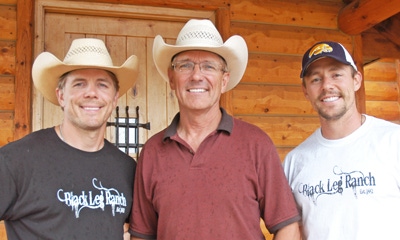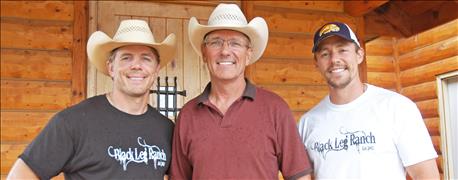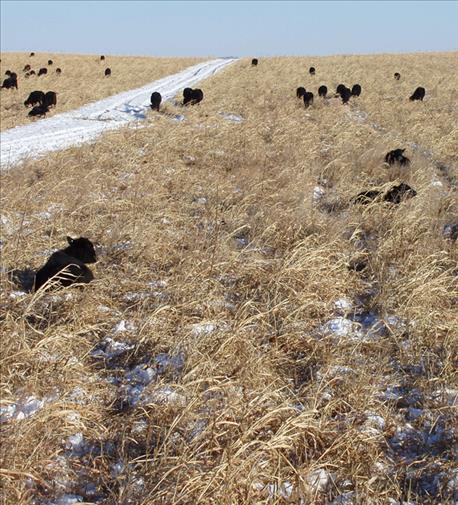July 28, 2016

Black Leg Ranch, McKenzie, N.D., is a regional winner in the National Cattlemen’s Beef Association’s Environmental Stewardship Award Program.
The Doan family — which includes Jerry and Renae Doan, Jeremy and Ashlee Doan, Jay and Kari Doan, Jayce Doan, and Shanda and Don Morgan — operate the ranch.
Homesteaded in 1882, Black Leg Ranch was named for the Angus cattle that were imported to stock it, some of the first Angus imported to the United States.

FAMILY AFFAIR: Jerry Doan (center), flanked by sons Jay (left) and Jeremy, along with other members of the family who operate Black Leg Ranch, were recognized with an Environmental Stewardship Award from the National Cattlemen’s Beef Association.
"My grandfather brought the first Angus cows to southern Burleigh County here in North Dakota in 1930. It was predominantly Hereford country, and people hated those black cattle," says Jerry. "It kind of started as a joke, and my grandfather was just enough of a character, he named [the ranch] that."
Today, the ranch comprises 17,000 acres in central North Dakota, where the Doan family partners with farmers on 3,000 acres of cropland, which allows the family to guide crop rotations, no-till practices and cover crops, while also providing residue for cattle forage.
Across the approximately 14,000 acres of grazing land, close attention is paid to soil health, which generates greater forage production, limits erosion and reduces costs.
The Doans have also implemented an intensive grazing program. They built more than 65 miles of high-tensile fence to create 90 pastures, allowing them to move cattle to new grass regularly to closely mimic the natural grazing behavior of the bison herds that once roamed the Plains.

WINTER GRAZING: Cows and calves graze a cover crop at Black Leg Ranch. Winter grazing is one of the practices used at the ranch to improve soil health and reduce impact on the environment.
"When Lewis and Clark were here, this was vast prairies of abundant grassland, and the buffalo basically did what we're trying to do with intensive grazing," Jerry says. "They came through with hundreds of thousands of head, and they kind of annihilated the land. But they didn't come back for a year or two, and that's basically what we're trying to mimic."
The family also uses cover crops to help build and protect soil quality by preventing wind and water from eroding the topsoil. The cover crops also help reduce input costs, while creating wildlife habitat and winter grazing opportunities, which lower feed costs for the cattle herd.
"When my dad was little, he said the land was fun to dirt-bike on because there were sand dunes everywhere," says Jayce. "Now with our improved grazing methods, we're able to cover that ground, and it's not as fun anymore for dirt bike riding, but it's a lot prettier and our soil health has gone up immensely."
The multigenerational ranch has added a hunting lodge and events center to allow current and future generations to make their living from the land, while also improving the resources in their care.
The North Dakota Stockmen's Association nominated the Doan family's Black Leg Ranch for the regional Environmental Stewardship Award Program Award. The ranch was named North Dakota's State ESAP winner in September 2015.
More to do
Jerry says there is “tons more” that his family could do on the ranch to improve it.
“We continue to learn more about our cover crops and saving costs by grazing all year long without hay,” he says. “We are experimenting with how long to leave the calves on the cows. Last year we went until late March, and I felt it went very well and was very cost-effective.
They are also exploring the grass-finishing opportunities.
“Jayce, my youngest, just came back to the ranch after graduating from Montana State with an animal science degree. We are exploring and finishing a few to see how it works, and what types of cover crops and forages can get us through the winter,” Jerry says.
The Bismarck Community Food Co-op opened in the Doan’s old Snoopers building. Snoopers was a recreational center the family operated in Bismarck.
“After 25 years and 15,000 birthday parties, we decided it was time to shift gears, and we own the building and allowed the food co-op to locate there. It is fun to see the excitement around this ag-food venture,” Jerry says.
They also have expanded their ag tourism venture. “We have hosted many different tours, events, weddings, etc.,” Jerry says. “It’s always fun to spread the positive message of agriculture and the beef industry.”
Their goal, Jerry says, is to have a good quality of life, improve and build natural resources, propagate wildlife resources, and be sound financially.
“We want this to be multigenerational. We want the ranch to be in better shape financially and physically than when we took over. This will happen through diversity and holistic management, allowing us to work to continually improve our rangelands and to improve the biology and organic matter in our cropland.”
Source: North Dakota Stockmen’s Association, along with contributions from Lon Tonneson.
You May Also Like




